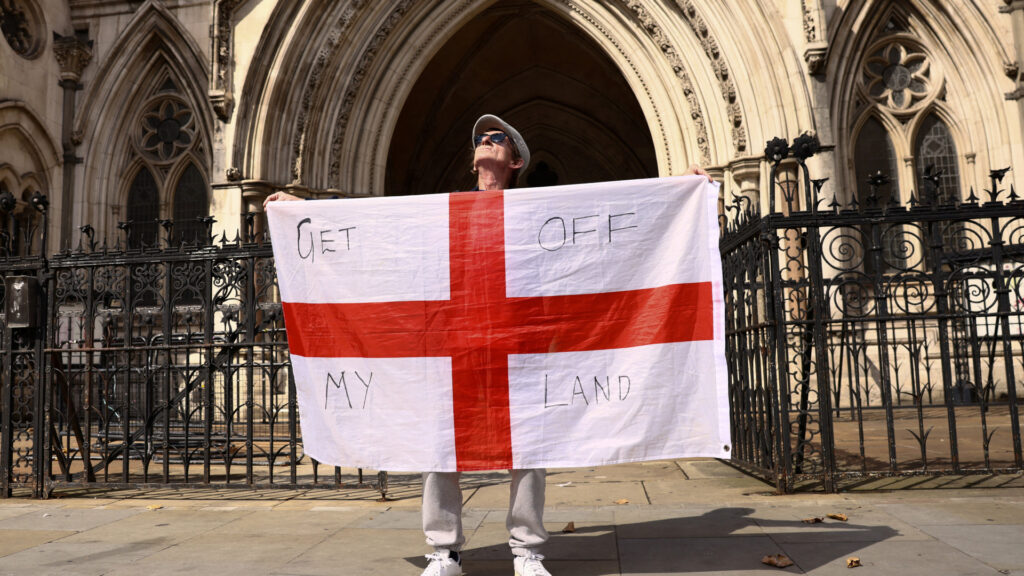A new type of nationalism is hitting British streets. So-called patriots are draping England’s red and white St George’s flag across lamp posts, houses and even the painted centres of roundabouts.
But with the flags has come a bigger question: what, exactly, do they represent?
I am a child of Luton, where my formative years coincided with the rise of the English Defence League (EDL), a far-right street movement founded in 2009 that became notorious for violent marches against Muslims.
Its founder, Tommy Robinson, also from Luton, made a name for himself by filming incendiary videos in Bury Park, the heart of the city’s South Asian community, before reinventing himself as a professional Islamophobe on the national stage.
Back then, there was a constant fear of attack, or that the EDL would march through Bury Park, the hub of Luton’s South Asian and Muslim communities.
New MEE newsletter: Jerusalem Dispatch
Sign up to get the latest insights and analysis on
Israel-Palestine, alongside Turkey Unpacked and other MEE newsletters
Whenever an EDL demonstration took place, one thing was always present – the flag, wielded viscerally and aggressively. Robinson would drive through Bury Park to film his videos about how “the country has gone down the drain”.
Whenever an EDL demonstration took place, one thing was always present – the flag, wielded viscerally and aggressively
In one video, he was famously slapped by an Asian Muslim man. His presence and the ideas of the EDL created such fear that leaving the house alone carried real risk.
Luton has come a long way since those dark days, with local communities working hard to bridge the divide. But because of those experiences, the flag has always meant one thing to me: racism and the violence that comes with it. It conjures images of empire and colonial humiliation – a violent reminder of how colonised peoples were treated.
Seeing it raised today makes clear that it has become a political tool: a signal that Muslims and Asians, alongside asylum seekers, particularly in places like Luton, are not welcome. That is the true meaning of this so-called pride.
Weaponised ‘pride’
In recent weeks, I have seen some minoritised people try to reclaim the flag, to say it should be a source of pride.
Others dismiss the displays as harmless, with some even plastering the flag on their doors as a form of protection. Either stance risks legitimising the act, or pretending it is benign when it is anything but.
There is a direct correlation between the sudden proliferation of flags and the violence unleashed outside hotels housing asylum seekers. The same is true of the violence that unfolded outside mosques and Muslim-majority areas across Britain last August, and the attacks in the Northern Irish town of Ballymena.

Flags, Farage and hotels: How the media is driving England into the arms of Reform
Read More »
Over the last two decades, Britain has experienced significant economic decline, with people struggling to understand why accessing basic necessities, such as visiting the doctor or buying groceries, has grown more challenging.
Far-right voices like the Reform Party are offering simple answers, blaming asylum seekers and a lack of “cultural pride”, while deflecting blame from Britain’s billionaire class, who have only profited from this decline.
But this supposed “cultural pride” is built on purging the nation of its minoritised communities – on declaring Britain white. In Luton, I have seen roundabouts painted in red and white and whole estates covered in St George’s and Union Jack flags, planted in areas with large Muslim and working-class populations. To deny the intent behind this is wilful blindness.
The double standard is striking. When local activists raised the Palestinian flag in Luton and other parts of the country as an act of solidarity, it was condemned by right-wing outlets like GB News.
Yet the St George’s flags are left untouched. This raises an unavoidable question: are local authorities complicit in normalising this rhetoric?
Symbol of exclusion
Even the prime minister has weighed in, boasting of the flag he keeps at home. What does it say about Britain when its leaders joins the flag debate in such an unproductive way, as racialised minorities fear doing the most mundane things?
We have already seen a Filipino nurse attacked in a park, Muslim men threatened with a knife outside a Portsmouth mosque, and a young Asian man racially abused live on television. These are not isolated incidents. They share the same rhetoric embodied by the flag.
Keir Starmer’s pandering to the far right has become almost routine. In a speech on immigration, he warned that the UK risks becoming “an island of strangers” – echoing the words of Enoch Powell’s infamous “Rivers of Blood” speech.
Powell sneered at arrivals from former colonies and predicted a time when “the black man holds the whip over the white man”. Such language pours fuel on a fire already burning, aimed squarely at targeting racialised communities for electoral gain.
For me, growing up in Luton meant living under the shadow of that flag – a shadow that invoked fear, intimidation and exclusion.
Today, when I see it flying from lamp posts or plastered across roundabouts, it does not speak of pride but power – namely, who belongs and who does not.
Until Britain reckons with that reality, the St George’s flag will remain not a unifying symbol, but a warning that Britain’s minority communities are simply not welcome here.
The views expressed in this article belong to the author and do not necessarily reflect the editorial policy of Middle East Eye.

